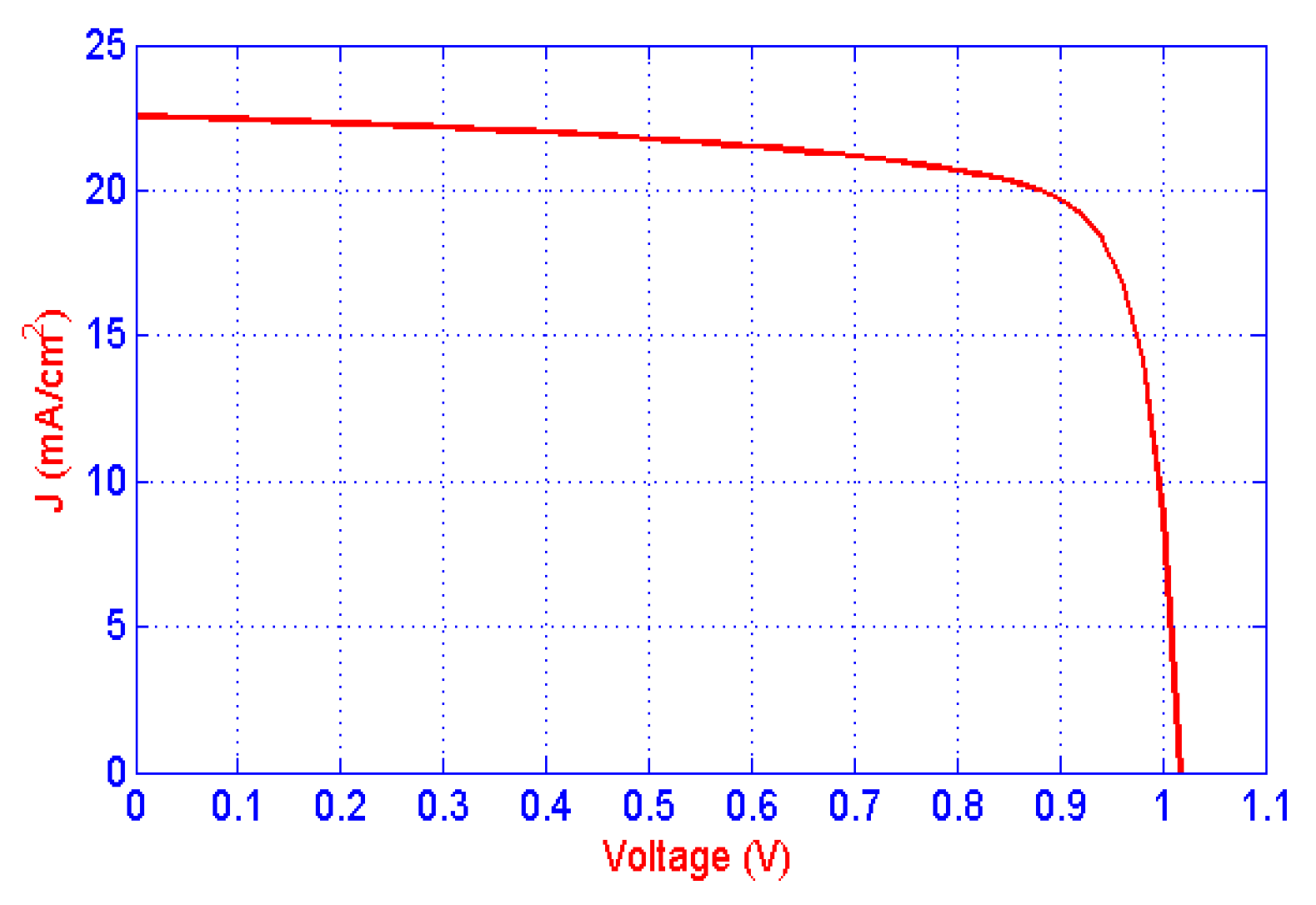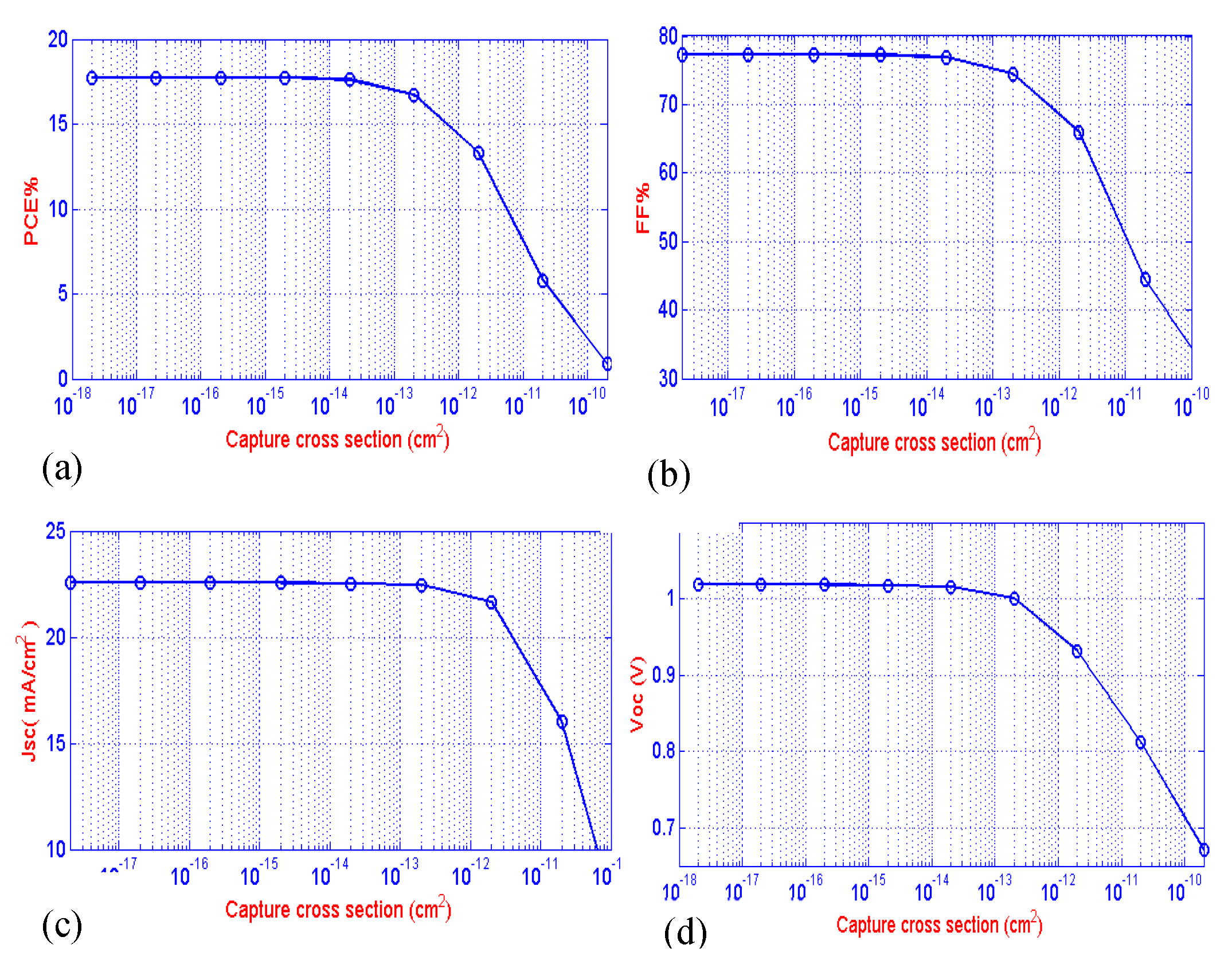Submitted:
05 June 2023
Posted:
05 June 2023
You are already at the latest version
Abstract
Keywords:
1. Introduction
2. Device Structure and Parameters
3. Result
3.1. The Influence of Defect Density in the Absorber Layer with Cu2O as the HTM Layer
3.2. The Effect of Capture Cross-Section in the Absorber Layer with Cu2O as HTM Layer
3.3. The Effect of Defect Density in HTM and ETM Interface Layers
3.4. The Effect of Defects Density on Photovoltaic Performance in MAPbI3 Absorber Layer for All Cells
3.5. The Effect of Defects on Quantum Efficiency with Cu2O as HTM Layer
3.6. Break Down Point Determination of Cell Performance in PSC
4. Conclusions
Author Contributions
Funding
Conflicts of Interest
References
- J. Huang, Y. Yuan, Y. Shao, and Y. Yan, “Understanding the physical properties of hybrid perovskites for photovoltaic applications,” Nat. Rev. Mater., vol. 2, (2017). [CrossRef]
- H. J. Snaith, “Present status and future prospects of perovskite photovoltaics,” Nat. Mater., vol. 17, no. 5, pp. 372–376, (2018). [CrossRef]
- D. Yang, Ruixia Yang, Kai Wang, Congcong Wu, Xuejie Zhu, Jiangshan Feng, Xiaodong Ren, Guojia Fang, Shashank Priya, and Shengzhong (Frank) Liu “High efficiency planar-type perovskite solar cells with negligible hysteresis using EDTA-complexed SnO2,” Nat. Commun., vol. 9, no. 1, (2018). [CrossRef]
- N. Yaghoobi Nia, D. Saranin, A. L. Palma, and A. Di Carlo, Perovskite solar cells. Elsevier Ltd., (2019).
- A. Kojima, K. Teshima, Y. Shirai, and T. Miyasaka, “Organometal halide perovskites as visible-light sensitizers for photovoltaic cells,” J. Am. Chem. Soc., vol. 131, no. 17, pp. 6050–6051, (2009). [CrossRef]
- Shubham, Raghvendra, C. Pathak, and S. K. Pandey, “Design, Performance, and Defect Density Analysis of Efficient Eco-Friendly Perovskite Solar Cell,” IEEE Trans. Electron Devices, vol. 67, no. 7, pp. 2837–2843, (2020). [CrossRef]
- M. S. Md. Shahariar Chowdhury, S.A. Shahahmadi, P. Chelvanathan, S.K. Tiong, Nowshad Amin, Kua-anan Techato, Narissara Nuthammachot, Tanjia Chowdhury, “Effect of Deep-Level Defect Density of the Absorber Layer and n/i Interface in Perovskite Solar Cells by SCAPS-1D,” Results Phys., no. S2211-3797(19)32121–7. [CrossRef]
- S. Mahjabin, MD. MA. Haque, K. Sobayel, M. S. Jamal, M. A. Islam, V. selvanathan, AB. Assaifan, H. Alharbi, K. Sopian, N. Amin, and MD. Akhtaruzzaman, “Perceiving of Defect Tolerance in Perovskite Absorber Layer for Efficient Perovskite Solar Cell,” IEEE Access, vol. 8. pp. 106346–106353, (2020). [CrossRef]
- F. Azri, A. Meftah, N. Sengouga, and A. Meftah, “Electron and hole transport layers optimization by numerical simulation of a perovskite solar cell,” Sol. energy, vol. 181, pp. 372–378, (2019). [CrossRef]
- A. S. Chouhan, N. P. Jasti, and S. Avasthi, “Effect of interface defect density on performance of perovskite solar cell: Correlation of simulation and experiment,” Mater. Lett., vol. 221, pp. 150–153, (2018). [CrossRef]
- G. A. Casas, M. A. Cappelletti, A. P. Cédola, B. M. Soucase, and E. L. Peltzer y Blancá, “Analysis of the power conversion efficiency of perovskite solar cells with different materials as Hole-Transport Layer by numerical simulations,” Superlattices Microstruct, vol. 107, pp. 136–143, (2017). [CrossRef]
- L. Lin, L. Jiang, Y. Qiu, and Y. Yu, “Modeling and analysis of HTM-free perovskite solar cells based on ZnO electron transport layer,” Superlattices Microstruct., vol. 104, pp. 167–177, (2017). [CrossRef]
- Y. Li, Weibo Yan2, Yunlong Li, Shufeng Wang, Wei Wang, Zuqiang Bian, Lixin Xiao & Qihuang Gong, “Direct Observation of Long Electron-Hole Diffusion Distance in CH 3 NH 3 PbI 3 Perovskite Thin Film,” Sci. Rep., vol. 5, no. April, pp. 1–8, (2015). [CrossRef]
- S. Fengjuan, T. Fuling, X. Hongtao, and Q. Rongfei, “Effects of defect states on the performance of perovskite solar cells,” J. Semicond., vol. 37, no. 7, p. 72003, 2016. [CrossRef]
- R. Rashmi Ranjan Kumar and S. Kumar Pandey, “Performance Improvement and Defects Analysis in Pervoskite based Solar Cell,” Conf. Rec. IEEE Photovolt. Spec. Conf., vol. 801106, pp. 1191–1194, 2019. [CrossRef]
- S. Mahjabin et al., “Perceiving of Defect Tolerance in Perovskite Absorber Layer for Efficient Perovskite Solar Cell,” IEEE Access, vol. 8. pp. 106346–106353, 2020. [CrossRef]
- Shubham, Raghvendra, C. Pathak, and S. K. Pandey, “Design, Performance, and Defect Density Analysis of Efficient Eco-Friendly Perovskite Solar Cell,” IEEE Trans. Electron Devices, vol. 67, no. 7, pp. 2837–2843, 2020. [CrossRef]
- S. Taheri, A. Ahmadkhan kordbacheh, M. Minbashi, and A. Hajjiah, “Effect of defects on high efficient perovskite solar cells,” Opt. Mater. (Amst)., vol. 111, no. October, 2021. [CrossRef]
- W. Ming, D. Yang, T. Li, L. Zhang, and M. H. Du, “Formation and Diffusion of Metal Impurities in Perovskite Solar Cell Material CH3NH3PbI3: Implications on Solar Cell Degradation and Choice of Electrode,” Adv. Sci., vol. 5, no. 2, (2018). [CrossRef]
- D. Macdonald and L. J. Geerligs, “Recombination activity of interstitial iron and other transition metal point defects in p- and n-type crystalline silicon,” Appl. Phys. Lett., vol. 85, no. 18, pp. 4061–4063. [CrossRef]
- J. Schmidt, Bianca Lim, Dominic Walter, Karsten Bothe, Sebastian Gatz, Thorsten Dullweber, and Pietro P. Altermatt., “Impurity-related limitations of next-generation industrial silicon solar cells,” IEEE J. Photovoltaics, vol. 3, no. 1, pp. 114–118, (2013). [CrossRef]
- H. Habenicht, M. C. Schubert, and W. Warta, “Imaging of chromium point defects in p-type silicon,” J. Appl. Phys., vol. 108, no. 3, (2010). [CrossRef]
- S. Martinuzzi, O. Palais, M. Pasquinelli, D. Barakel, and F. Ferrazza, “N-type multicrystalline silicon wafers for solar cells,” Conf. Rec. IEEE Photovolt. Spec. Conf., pp. 919–922, (2005). [CrossRef]










 |
 |
Disclaimer/Publisher’s Note: The statements, opinions and data contained in all publications are solely those of the individual author(s) and contributor(s) and not of MDPI and/or the editor(s). MDPI and/or the editor(s) disclaim responsibility for any injury to people or property resulting from any ideas, methods, instructions or products referred to in the content. |
© 2023 by the authors. Licensee MDPI, Basel, Switzerland. This article is an open access article distributed under the terms and conditions of the Creative Commons Attribution (CC BY) license (http://creativecommons.org/licenses/by/4.0/).





